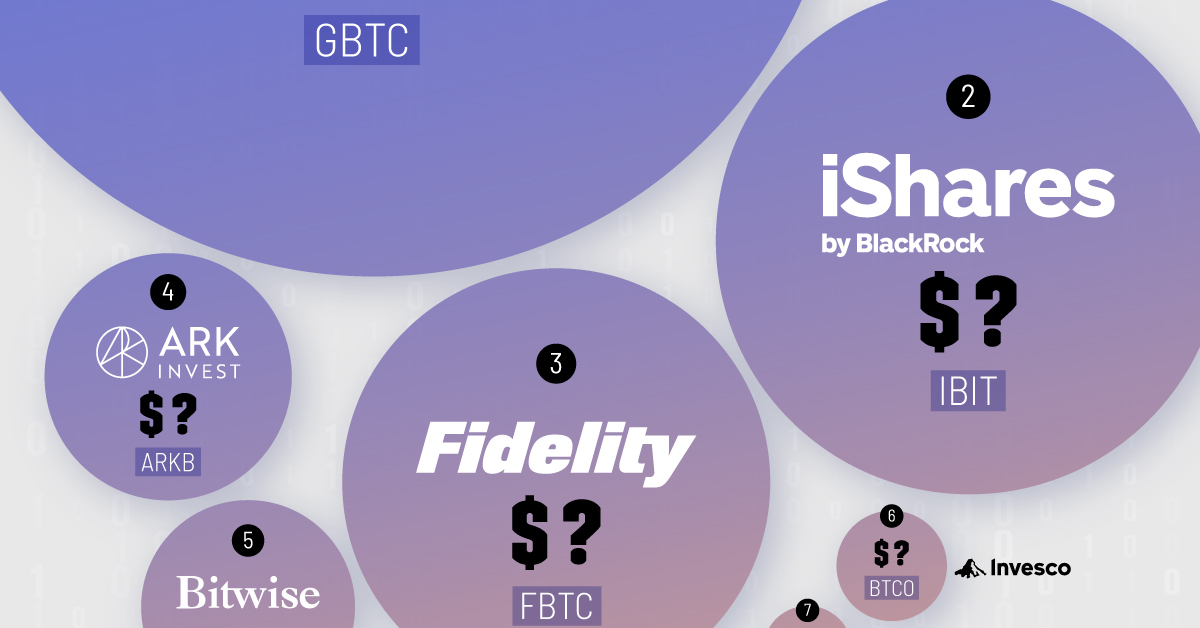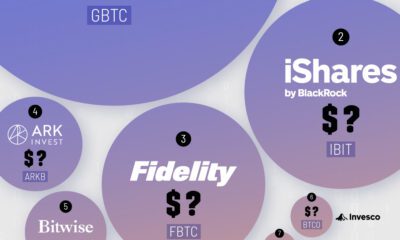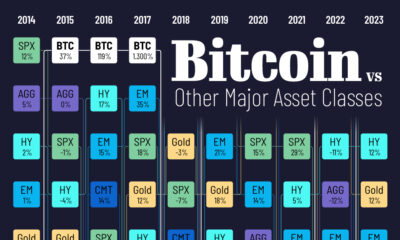Cryptocurrency
Cryptocurrency: Redefining the Future of Finance

Cryptocurrency: Redefining the Future of Finance
Cryptocurrency is a thriving ecosystem, quietly encroaching on conventional finance’s territory.
Over the last five years, Bitcoin users and transactions have averaged a growth rate of nearly 60% per year. Similarly, private and public investors have deepened their commitment to cryptocurrencies including Ethereum, Ripple (XRP), and Stellar—and a number of others across the industry.
Today’s infographic unpacks a cross-section of cryptocurrencies, stakeholders, and core applications across a sector that’s continuing to grow in importance.
The Evolution of Cryptocurrency
Cryptocurrency has erupted into a $200 billion industry, sparking a wave of global disruption.
At the heart of cryptocurrency is a rich history of innovation. It extends back to the 1980s with advances in the field of cryptography—eventually leading to the technology that forms encryption techniques designed to protect the network.
Since then, a series of key events have continued to shape the sector.
| Year | Event |
|---|---|
| 2009 | Satoshi Nakamoto mines the first Bitcoin on a decentralized network |
| 2011 | Litecoin launches |
| 2012 | Ripple is founded |
| 2013 | The price of a single Bitcoin reaches $1,000 |
| 2015 | Ethereum launches, introducing smart contracts into the crypto ecosystem |
| 2017 | Over 1,000 cryptocurrencies listed |
| 2017 | Bitcoin's price rockets past $10,000, reaching a peak just shy of $20,000 |
| 2018 | EOS offers a blockchain-based infrastructure for decentralized apps (DApps) |
Now, there are over 5,000 cryptocurrencies in circulation, with many built on innovative applications and use-cases as the ecosystem rapidly evolves.
The Value of Cryptocurrencies
Today, crypto offers cutting-edge advances that are diverse and transformative. In addition, it could also be considered an investment in tomorrow’s financial system—decentralized finance (DeFi).
DeFi is an emerging alternative financial system that is built on a public blockchain, which enables greater accessibility because anyone has the ability to connect to it. Additionally, transactions are publicly visible, enabling greater transparency across the system.
Here is a refresher on some of the practical advantages being applied across cryptocurrencies.
| Use Cases | Name | Description |
|---|---|---|
| Payments | Bitcoin Ripple (XRP) Stellar Dash | Used for purchasing goods without the need of a trusted third-party |
| Value Storage | Bitcoin Litecoin | As the total supply of many cryptocurrencies are limited, this scarcity influences their value |
| Stablecoins | DAI USDC GeminiUSD | Digital money that is typically pegged to a currency or commodity, such as gold |
| Privacy | Monero Zcash | Cryptography, the technology behind crypto, can enable the anonymity of its owners |
| Digital Ownership | Bitcoin Ripple (XRP) Stellar | Can empower those without access to a bank to enter the financial system |
| Digital Gold | Bitcoin | Bitcoin shares similar attributes to money: a medium of exchange, unit of account, and store of value |
| Decentralized Apps (DApps) | EOS Tezos Ethereum (ETH) | Enable individuals to create apps without a central authority, directly connecting the user and creator |
The Key Players in the Crypto Landscape
The cryptocurrency ecosystem is growing rapidly. Worldwide, private and public actors recognize its potential across many domains.
Who are the primary participants in the field today?
Private Actors
- Institutional Investors
Harvard Endowment Fund, Crypto Hedge Funds - Cryptocurrency Exchanges
Coinbase, Bitstamp - Banks & Finance
J.P. Morgan, Fidelity Investments, Swissquote - Tech
IBM, Microsoft - Power & Utilities
RWE
Public Actors
- Governments
Venezuela - Central Banks
China, Sweden, Saudi Arabia - Organizations
Crypto Valley Association, Global Digital Finance
The rising popularity of crypto is bolstering new policies and adoption, as evidenced by the many players trying to break into the space.
The Big Picture:
As crypto continues to gain momentum, its longer-term implications will come into focus. Crucially, its cryptographic foundation sets the stage for future advances in finance.
- Privacy
Anonymized transactions protect users data through cryptographic techniques - Access
Providing a new financial model for 1.7B unbanked individuals around the world - Efficiency
Steep reductions in settlement time and efficacy could save consumers $16 billion annually - Security
Providing immutable, traceable records of security-rich transactional networks - Programmable Money
Smart contracts could drastically eliminate manual and administrative work— ultimately bypassing them altogether
Rooted in decentralized and autonomous systems, cryptocurrencies are creating second-order effects in the financial world. Ultimately, cryptocurrencies are helping to transform finance as we know it—unlocking countless investment opportunities across the global economy.
Technology
Ranked: The Largest Bitcoin ETFs in the U.S.
In this graphic, we rank the top eight Bitcoin ETFs in the U.S. by their total assets under management (AUM).

Ranking the Largest Bitcoin ETFs in the U.S.
This was originally posted on our Voronoi app. Download the app for free on iOS or Android and discover incredible data-driven charts from a variety of trusted sources.
In early January 2024, the U.S. Securities and Exchange Commission (U.S. SEC) gave its approval on exchange-traded funds (ETFs) to track Bitcoin, giving investors an alternative pathway to accessing the world’s biggest cryptocurrency.
In this graphic, we’ve shown the eight largest Bitcoin ETFs in the U.S. by assets under management (AUM), as of Feb. 27, 2024. To elaborate, these are ETFs that buy and hold actual Bitcoin, meaning their performance will generally follow that of Bitcoin itself.
The data used to create this graphic was sourced from VettaFi.
| ETF Name | Ticker | AUM |
|---|---|---|
| Grayscale Bitcoin Trust | GBTC | $22.7B |
| iShares Bitcoin Trust Registered | IBIT | $6.6B |
| Fidelity Wise Origin Bitcoin Fund | FBTC | $4.7B |
| ARK 21Shares Bitcoin ETF | ARKB | $1.6B |
| Bitwise Bitcoin ETF Trust | BITB | $1.2B |
| Invesco Galaxy Bitcoin ETF | BTCO | $314M |
| VanEck Bitcoin Trust | HODL | $205M |
| Valkyrie Bitcoin Fund | BRRR | $159M |
From these numbers we can see that Grayscale’s Bitcoin Trust (GBTC) is the largest by a wide margin. As its name implies, GBTC was originally structured as a trust, but was converted to an ETF on Jan. 11, 2024.
Why Buy a Bitcoin ETF?
Bitcoin ETFs simplify the process of buying and storing Bitcoin. This is because they can be purchased within a traditional brokerage account, just like any other ETF or stock.
Instead of having to think about creating a wallet, memorizing a 12-word seed phrase and holding their keys, this product scraps all of that and provides a well-known path: buy an ETF. This will open the digital asset space to a broader investor base.
Rita Martins, former Head of FinTech Partnerships, HSBC
Investors should be aware that these ETFs charge an expense ratio, which could eat into returns. Information on fees can be easily found on each asset manager’s relevant fund page.
For more visualizations related to Bitcoin, consider this graphic which shows how Bitcoin has performed relative to other major asset classes over the past 10 years.
-

 Education1 week ago
Education1 week agoHow Hard Is It to Get Into an Ivy League School?
-

 Technology2 weeks ago
Technology2 weeks agoRanked: Semiconductor Companies by Industry Revenue Share
-

 Markets2 weeks ago
Markets2 weeks agoRanked: The World’s Top Flight Routes, by Revenue
-

 Demographics2 weeks ago
Demographics2 weeks agoPopulation Projections: The World’s 6 Largest Countries in 2075
-

 Markets2 weeks ago
Markets2 weeks agoThe Top 10 States by Real GDP Growth in 2023
-

 Demographics2 weeks ago
Demographics2 weeks agoThe Smallest Gender Wage Gaps in OECD Countries
-

 Economy2 weeks ago
Economy2 weeks agoWhere U.S. Inflation Hit the Hardest in March 2024
-

 Green2 weeks ago
Green2 weeks agoTop Countries By Forest Growth Since 2001













